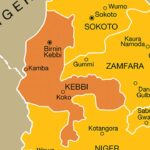Following a flood disaster that hit Kebbi State recently, farming and commercial activities have been brought to a standstill owing to the collapse of five bridges across three local government areas of the state.
The people of the affected LGAs, mostly farmers and businessmen that need to move goods and farm inputs, have found it difficult to do so as vehicles cannot ply the roads.
- Agric extension officer urges Abians to embrace cassava farming
- Despite challenges, women take up rice farming in Kebbi
Daily Trust gathered that before the roads became unmotorable, drivers of commercial vehicles used to pay tokens to youths that stationed themselves at the spots of the collapsed bridges to help push vehicles cross over.
However, as the flood further eroded the areas around the collapsed bridges, movement became impossible which has led to the commercial vehicles abandoning the roads.
The bridges were said to have collapsed as a result of the overflows of Rivers Niger and Rima.
Three of the bridges, one each, collapsed in Bagudo, Arewa and Birnin Kebbi LGAs. The bridge in Bagudo is between Illo and Lolo villages, the one in Birnin Kebbi is along Dukku/Makera road, while the one Arewa LGA is in Jaffeji village.
Speaking on the incidents, the Chairman of Kebbi State Emergency Management Agency (SEMA), Sank Dododo, declared that five bridges collapsed in three LGAs of the state with one each in Birnin Kebbi and Arewa and three in Bagudo.
Dododo said the flood destroyed the bridges as a result of heavy flow of water from Rivers Rima and Niger and that the two rivers traversed the state for about 500 kilometres.
He explained that the overflows destroyed farms and sacked all the villages along the river banks, as well as wreaked havoc on roads which led to the collapse of the bridges.
According to him, earlier in the year, the Nigerian Metrological Agency (NIMET) predicted that 11 LGAs in the state would experience flooding.
Dododo argued that in contrast with the earlier prediction, four more LGAs in the state had now been overrun by the flood thereby bringing the total of LGAs affected in the state to 15.
He further said for one to be able to understand the enormous nature of the disaster, the four additional LGAs were not along river banks and were among those considered as safe.
He attributed the yearly flooding in the state to lack of capacity by the two dams that discharged water to the state to contain the volumes of water that got to them, adding that it was over 40 years now that the Goronyo Dam in Sokoto and Bakalori Dam in Zamfara had not been de-silted.
A businessman, Usman Bawa Bagudo, said vehicles could not cross the bridges owing to their collapse and that his goods which were heavy could not be carried over by people.
Bagudo said the collapse of the bridges did not only lead to the collapse of businesses in the localities, but also affected farming activities.
He further told this reporter that along Lolo Road, there were spots where two other bridges collapsed.
Salisu Sani from Tsamiya village lamented over the collapse of the bridges, saying it had brought poor attendance at his village market.
Sani said what disturbed him most was that the businessmen that usually supplied them with agro inputs could not come to the market, and that if intervention did not come their way it would affect farm output.
He further lamented that, “You can’t reach us from our local government headquarters, Bagudo, nor can anybody from Lolo. We have been cut off from both ends.”

 Join Daily Trust WhatsApp Community For Quick Access To News and Happenings Around You.
Join Daily Trust WhatsApp Community For Quick Access To News and Happenings Around You.

